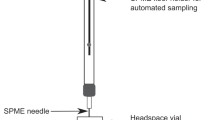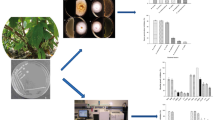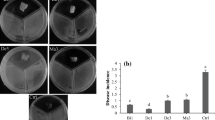Abstract
A total of 49 endophytic bacteria isolated from sugarcane were screened in vitro for antagonistic property against C. falcatum through production of volatile organic compounds (VOCs). Among them, 27 bacteria produced volatiles with moderate inhibitory level, i.e. 30 to 50% and 9 produced volatiles with strong inhibitory properties, i.e. > 50% mycelial growth inhibition over control. The volatile compounds produced by B. axarquiensis—ESR 7 inhibited C. falcatum mycelia growth to the tune of 59.2% followed by B. licheniformis—ESR 26 (57.8%) and B. subtilis—ESR 24 (54.8%), respectively. The volatiles produced by bacteria not only inhibited the radial growth of mycelium but also suppressed the vertical expansion of mycelia and caused deformation in mycelia growth. The VOCs produced by 24 endophytic bacteria completely inhibited spore formation in C. falcatum culture. Profiling of antagonistic VOCs produced by bacterial strains ESR 7, ESR 24 and ESR 26 was done by head space-solid phase microextraction (SPME) coupled with gas chromatography mass spectral analysis. The analysis showed the presence of 63 compounds belonging to chemical groups of alcohols, esters, hydrocarbons, ketones, acids, amino acid, carbohydrates, ethers, aldehydes, amines and amides. Among the identified microbial volatiles, 6 compounds viz., acetic acid, methoxy-phenyl-oxime, octamethyl-cyclotetrasiloxane, 5,7-dimethyl-undecane, hexamethyl-cyclotrisiloxane and dodecane were reported in VOCs produced by all three bacteria. However, among 63 volatiles, only 31 were already reported to be produced by many bacteria and fungi and 11 compounds viz., acetic acid, hexanal, 2-ethyl-1-hexanol, undecane 5,7-dimethyl, undecane 3,7-dimethyl, 2-decanone, dodecane, 2-undecanone, 2-dodecanone, 1,2-Benzenedicarboxylic acid, diisooctyl ester and 2-methyl-hexadecanol were reported with antagonistic property against many plant pathogens. The study revealed that many VOCs produced by B. axarquiensis—ESR 7, B. subtilis—ESR 24 and B. licheniformis—ESR 26 play role in mediating antagonism against C. falcatum.


Similar content being viewed by others
References
Ahmad, M., R. Ali, and S. Fasihi. 1986. Effect of different infection levels of red rot of sugarcane on cane weight and juice quality. Journal of Agricultural Research (Lahore) 24: 129–131.
Ajilogba, C.F., and O.O. Babalola. 2019. GC–MS analysis of volatile organic compounds from Bambara groundnut rhizobacteria and their antibacterial properties. World Journal of Microbiology & Biotechnology 35: 83. https://doi.org/10.1007/s11274-019-2660-7.
Amaresan, N., V. Jayakumar, Krishna kumar, and N. Thajuddin. 2019. Biocontrol and plant growth-promoting ability of plant-associated bacteria from tomato (Lycopersicum esculentum) under field condition. Microbial Pathogenesis 136: 103713. https://doi.org/10.1016/j.micpath.2019.103713.
Banerjee, D., G. Strobel, B. Geary, J. Sears, D. Ezra, O. Liarzi, and J. Coombs. 2010. Muscodor albus strain GBA, an endophytic fungus of Ginkgobiloba from United States of America, produces volatile antimicrobials. Mycology 1(3): 179–186. https://doi.org/10.1080/21501203.2010.506204.
Barber, C.A. 1901. Sugarcane disease in Godawari and Ganjam districts. Madras Department Land Records and Agricultural Bulletin 512(43): 181–194.
Berg, G., A. Krechel, M. Ditz, R.A. Sikora, A. Ulrich, and J. Hallmann. 2005. Endophytic and ectophytic potato-associated bacterial communities differ in structure and antagonistic function against plant pathogenic fungi. FEMS Microbiology Ecology 51: 215–229.
Bojke, A., C. Tkaczuk, P. Stepnowski, and M. Gołębiowski. 2018. Comparison of volatile compounds released by entomopathogenic fungi. Microbiological Research 214: 129–136. https://doi.org/10.1016/j.micres.2018.06.011.
Che, J., B. Liu, G. Liu, Q. Chen, and J. Lan. 2017. Volatile organic compounds produced by Lysinibacillus sp. FJAT-4748 possess antifungal activity against Colletotrichum acutatum. Biocontrol Science and Technology 27: 1349–1362. https://doi.org/10.1080/09583157.2017.1397600.
Chen, H., X. Xiang, W. Jun, W. Lijun, Z. Zheng, and Y. Zengliang. 2008. Antagonistic effects of volatiles generated by Bacillus subtilis on spore germination and hyphal growth of the plant pathogen, Botrytis cinerea. Biotechnology Letters 30: 919–923. https://doi.org/10.1007/s10529-007-9626-9.
Chen, Y., K. Gozzi, F. Yan, and Y. Chai. 2015. Acetic acid acts as a volatile signal to stimulate bacterial biofilm formation. mBio 6(3): e00392. https://doi.org/10.1128/mBio.00392-15.
Chona, B.L. 1980. Red rot of sugarcane and sugar industry- a review. Indian Phytopathology 33: 191–206.
Chona, B.L., and G.W. Padwick. 1942. More light on the red rot epidemic. Indian Farming 3: 70–73.
Compant, S., C. Clĕment, and A. Sessitsch. 2010. Plant growth-promoting bacteria in the rhizo- and endosphere of plants: Their role, colonization, mechanisms involved and prospects for utilization. Soil Biology & Biochemistry 42: 669–678.
Crespo, R., N. Pedrini, Juárez, and G.M. Dal Bello. 2008. Volatile organic compounds released by the entomopathogenic fungus Beauveria bassiana. Microbiological Research 163: 148–151. https://doi.org/10.1016/j.micres.2006.03.013.
Daungfu, O., S. Youpensuk, and S. Lumyong. 2019. Endophytic bacteria isolated from citrus plants for biological control of citrus canker in lime plants. Tropical Life Sciences Research 30(1): 73–88. https://doi.org/10.21315/tlsr2019.30.1.5.
Farag, M.A., C.M. Ryu, L.W. Sumner, and P.W. Paré. 2006. GC-MS SPME profiling of rhizobacterial volatiles reveals prospective inducers of growth promotion and induced systemic resistance in plants. Phytochemistry 67: 2262–2268. https://doi.org/10.1016/j.phytochem.2006.07.021.
Fernando, W.G.D., R. Ramarathnam, A.S. Krishnamoorthy, and S.C. Savchuk. 2005. Identification and use of potential bacterial organic antifungal volatiles in biocontrol. Soil Biology & Biochemistry 37: 955–964.
Gao, H., P. Li, X. Xu, Q. Zeng, and W. Guan. 2018. Research on volatile organic compounds from Bacillus subtilis cf-3: Biocontrol effects on fruit fungal pathogens and dynamic changes during fermentation. Frontiers in Microbiology 9: 456. https://doi.org/10.3389/fmicb.2018.00456.
Giorgio, A., A. De Stradis, P. Lo Cantore, and N.S. Iacobellis. 2015. Biocide effects of volatile organic compounds produced by potential biocontrol rhizobacteria on Sclerotinia sclerotiorum. Frontiers in Microbiology 6: 1056. https://doi.org/10.3389/fmicb.2015.01056.
Gu, Y.-Q., M.-H. Mo, J.P. Zhou, C.-S. Zou, and K.-Q. Zhang. 2007. Evaluation and identification of potential organic nematicidal volatiles from soil bacteria. Soil Biology & Biochemistry 39: 2567–2575.
Guevara-Avendaño, E., A.A. Bejarano-Bolívar, A.L. Kiel-Martínez, M. Ramírez-Vázquez, A. Méndez-Bravo, E.A. von Wobeser, D. Sánchez-Rangel, J.A. Guerrero-Analco, A. Eskalen, and F. Reverchon. 2019. Avocado rhizobacteria emit volatile organic compounds with antifungal activity against Fusarium solani, Fusarium sp. associated with Kuroshio shot hole borer, and Colletotrichum gloeosporioides. Microbiological Research 219: 74–83. https://doi.org/10.1016/j.micres.2018.11.009.
Guneser, O., A. Demirkol, Y.K. Yuceer, S.O. Togayc, M.I. Hosoglub, and M. Elibol. 2017. Production of flavor compounds from olive mill waste by Rhizopus oryzae and Candida tropicalis. Brazilian Journal of Microbiology 48: 275–285.
Hanif, S., B. Stodart, S. Savocchia, and G. Ash. 2019. Profiling volatile organic compounds produced by Bacillus species with biocontrol properties against Leptosphaeria maculans. pp. 265. Abstract from Australasian Plant Pathology Society Conference, Melbourne, Australia.
Hassan, M.N., S. Afghan, and F.Y. Hafeez. 2011. Biological control of red rot in sugarcane by native pyoluteorin-producing Pseudomonas putida strain NH-50 under field conditions and its potential modes of action. Pest Management Science 67(9): 1147–1154. https://doi.org/10.1002/ps.2165.
Hassan, M.N., S. Afghan, and F.Y. Hafeez. 2012. Biological suppression of sugarcane red rot by Bacillus spp. under field conditions. Journal of Plant Pathology 94(2): 325–329.
Heenan-Daly, D., S.L.S. Velivelli, and B.D. Prestwich. 2019. The role of rhizobacterial volatile organic compounds in a second green revolution—the story so far. In Field crops: Sustainable management by PGPR. Sustainable development and biodiversity 23, ed. D.K. Maheshwari and S. Dheeman, 191–220. Cham: Springer. https://doi.org/10.1007/978-3-030-30926-8_8.
Herrera, S.D., C. Grossi, M. Zawoznik, and M.D. Groppa. 2016. Wheat seeds harbour bacterial endophytes with potential as plant growth promoters and biocontrol agents of Fusarium graminearum. Microbiological Research 186–187: 37–43. https://doi.org/10.1016/j.micres.2016.03.002.
Hoon, K.S., H.S. Cho, H. Cheong, C.M. Ryu, J.F. Kim, and S.H. Park. 2007. Two bacterial entophytes eliciting both plant growth promotion and plant defense on pepper (Capsicum annuum L.). Journal of Microbial Biotechnology 17(1): 96–103.
Hsu, J.C. 1996. Multiple comparisons: Theory and methods. London: Chapman & Hall.
Jayakumar, V., A. Ramesh Sundar, and R. Viswanathan. 2019. Biological suppression of sugarcane smut with endophytic bacteria. Sugar Tech 21(4): 653–660. https://doi.org/10.1007/s12355-018-0684-1.
Jayakumar, V., R. Bhaskaran, and S. Tsushima. 2007. Potential of plant extracts in combination with bacterial antagonist treatment as biocontrol agent of red rot of sugarcane. Canadian Journal of Microbiology 53(2): 196–206.
Jeleń, H.H. 2003. Use of solid phase microextraction (SPME) for profiling fungal volatile metabolites. Letters in Applied Microbiology 36: 263–267.
Joshi, D., J. Gupta, A. Mishra, M. Upadhyaya, S.K. Holkar, and P. Singh. 2019a. Distribution, composition and bioactivity of endophytic Trichoderma spp. associated with Sugarcane. Proceedings of the National Academy of Sciences, India, Section B: Biological Sciences 89: 1189–1200. https://doi.org/10.1007/s40011-018-1036-3.
Joshi, D., P. Singh, S.K. Holkar, and S. Kumar. 2019b. Trichoderma-mediated suppression of red rot of sugarcane under field conditions in subtropical India. Sugar Tech 21(3): 496–504. https://doi.org/10.1007/s12355-018-0624-0.
Kanchiswamy, C.N., M. Malnoy, and M.E. Maffei. 2015. Chemical diversity of microbial volatiles and their potential for plant growth and productivity. Frontiers in Plant Science 6: 151. https://doi.org/10.3389/fpls.2015.00151.
Katoch, M., K. Bindu, S. Phull, and M.K. Verma. 2017. An endophytic Fusarium sp. isolated from Monarda citriodora produces the industrially important plant-like volatile organic compound hexanal. Microbiology 163: 840–847. https://doi.org/10.1099/mic.0.000479.
Kirtikar, and H.S. Verma. 1962. A review on effect of sugarcane diseases on yield and juice qualities in Uttar Pradesh. Indian Sugar 12: 103–108.
Kloepper, J.W., and C.M. Ryu. 2006. Bacterial endophytes as elicitors of induced systemic resistance. In Microbial root endophytes. Soil Biology, vol. 9, ed. B.J.E. Schulz, C.J.C. Boyle and T.N. Sieber, 33–52. Berlin, Heidelberg: Springer. https://doi.org/10.1007/3-540-33526-9_3.
Kudalkar, P., G. Strobel, S. Riyaz-Ul-Hassan, B. Geary, and J. Sears. 2012. Muscodor sutura, a novel endophytic fungus with volatile antibiotic activities. Mycoscience 53: 319–325. https://doi.org/10.1007/s10267-011-0165-9.
Kumar, A., and Satyavir. 1998. Evaluation of biological control agents against red rot (Colletotrichum falcatum) of sugarcane. Tests of Agrochemicals and Cultivars 19: 72–73.
Kumar, S., V. Kumar, and V. Kumar. 2000. Deterioration in juice quality of sugarcane due to pathotypes of red rot pathogen. Annals of Agri-Bio Research 5: 31–35.
Lee, S., M. Yap, G. Behringer, R. Hung, and J.W. Bennett. 2016. Volatile organic compounds emitted by Trichoderma species mediate plant growth. Fungal Biology and Biotechnology 3: 7. https://doi.org/10.1186/s40694-016-0025-7.
Liu, W., W. Mu, Z. Bingyu, and L. Feng. 2008. Antifungal activities and components of VOCs produced by Bacillus subtilis G8. Current Research in Bacteriology 1(1): 28–34. https://doi.org/10.3923/crb.2008.28.34.
Liu, X.-M., and H. Zhang. 2015. The effects of bacterial volatile emissions on plant abiotic stress tolerance. Frontiers in Plant Science 6: 774. https://doi.org/10.3389/fpls.2015.00774.
Lodewyckx, C., J. Vangronsveld, F. Porteous, E.R.B. Moore, S. Taghavi, M. Mezgeay, and D.V.D. Lelie. 2002. Endophytic bacteria and their potential applications. Critical Reviews in Plant Sciences 21(6): 583–606. https://doi.org/10.1080/0735-260291044377.
Mallaiah, B., E. Rajinikanth, and M. Muthamilan. 2016. Isolation and identification of secondary metabolites produced by Trichoderma viride inhibiting the growth of Fusarium in Carnatum (desm.) sacc. incitant of crossandra wilt. The Bioscan 11(3): 1525–1529.
Massawe, V.C., A. Hanif, A. Farzand, D.K. Mburu, S.O. Ochola, L. Wu, H.A.S. Tahir, Q. Gu, H. Wu, and X. Gao. 2018. Compounds of endophytic Bacillus spp. have biocontrol activity against Sclerotiana sclerotiorum. Phytopathology 108: 1373–1385.
Nagendran, K., G. Karthikeyan, P. Mohammed Faisal, P. Kalaiselvi, M. Raveendran, K. Prabakar, and T. Raguchander. 2014. Exploiting endophytic bacteria for the management of sheath blight disease in rice. Biological Agriculture & Horticulture 30(1): 8–23. https://doi.org/10.1080/01448765.2013.841099.
Padmanaban, P., D. Mohanraj, R. Viswanathan, M.M. Rao, N. Prakasam, R. Jothi, and K.C. Alexander. 1996. Differential interaction of sugarcane clones to pathotypes of Colletotrichum falcatum Went. Sugar Cane 4: 16–20.
Patel, P., R. Shah, B. Joshi, K. Ramar, and N. Amaresan. 2019. Molecular identification and biocontrol activity of sugarcane rhizosphere bacteria against red rot pathogen Colletotrichum falcatum. Biotechnology Reports 21: e00317. https://doi.org/10.1016/j.btre.2019.e00317.
Rath, M., T.R. Mitchell, and S.E. Gold. 2018. Volatiles produced by Bacillus mojavensis RRC101 act as plant growth modulators and are strongly culture-dependent. Microbiological Research 208: 76–84.
Raza, W., J. Yuan, N. Ling, Q. Huang, and Q. Shen. 2015. Production of volatile organic compounds by an antagonistic strain Paenibacillus polymyxa WR-2 in the presence of root exudates and organic fertilizer and their antifungal activity against Fusarium oxysporum f. sp. niveum. Biological Control 80: 89–95. https://doi.org/10.1016/j.biocontrol.2014.09.004.
Ryu, C.M., M.A. Farag, C.H. Hu, M.S. Reddy, J.W. Kloepper, and P.W. Pare. 2004. Bacterial volatiles induce systemic resistance in arabidopsis. Plant Physiology 134: 1017–1026.
Satyavir, A. Kumar, K. Raj, and K.S. Virk. 2002. Red rot of sugarcane: The research scene in Haryana. In Sugarcane crop management, ed. S.B. Singh, G.P. Rao and S. Eswaramoorthy, 109–126. Houston: SCI TECH Publishing, LLC.
Satyavir, 2003. Red rot of sugarcane current scenario. Indian Phytopathology 56: 245–254.
Schulz, S., and J.S. Dickschat. 2007. Bacterial volatiles: The smell of small organism. Natural Product Reports 24: 814–842.
Selim, H.M.M., N.M. Gomaa, and A.M.M. Essa. 2017. Application of endophytic bacteria for the biocontrol of Rhizoctonia solani (Cantharellales: Ceratobasidiaceae) damping-off disease in cotton seedlings. Biocontrol Science and Technology 27: 81–95. https://doi.org/10.1080/09583157.2016.1258452.
Sharma, G., J. Singh, A. Arya, and S.R. Sharma. 2017. Biology and management of sugarcane red rot: A review. Plant Archives 17: 775–784.
Sheoran, N., A.V. Nadakkakath, V. Munjal, A. Kundu, K. Subaharan, V. Venugopal, S. Rajamma, S.J. Eapen, and A. Kumar. 2015. Genetic analysis of plant endophytic Pseudomonas putida BP25 and chemo-profiling of its antimicrobial volatile organic compounds. Microbiological Research 173: 66–78.
Sileshi, G.W. 2012. A critique of current trends in the statistical analysis of seed germination and viability data. Seed Science Research 22: 145–159.
Singh, N. 2008. Sustainable management of red rot disease of sugarcane. Indian Sugar 8: 21–30.
Singh, O.N., and K.S. Waraitch. 1977. Metabolic changes induced by Colletotrichum falcatum Went. in sugarcane. Sugarcane Pathologists’ Newsletter 19: 7–9.
Singh, V., R.L. Srivastava, S.K. Awasthi, and B.B. Joshi. 2008. Biological control of red rot disease of sugarcane through Trichoderma harzianum and Trichoderma viride. Indian Phytopathology 61: 486–491.
Strobel, G. 2006. Muscodor albus and its biological promise. Journal of Industrial Microbiology and Biotechnology 33: 514–522. https://doi.org/10.1007/s10295-006-0090-7.
Tahir, H.A.S., Q. Gu, H. Wu, Y. Niu, R. Huo, and X. Gao. 2017. Bacillus volatiles adversely affect the physiology and ultra-structure of Ralstonia solanacearum and induce systemic resistance in tobacco against bacterial wilt. Scientific Reports 7: 40481. https://doi.org/10.1038/srep4048.
Tait, E., J.D. Perry, S.P. Stanforth, and J.R. Dean. 2014. Identification of volatile organic compounds produced by bacteria using HS-SPME-GC–MS. Journal of Chromatographic Science 52: 363–373.
Thode, H.C. 2002. Testing for normality. New York: Marcel Dekkers.
Ting, A.S.Y., S.W. Mah, and C.S. Tee. 2009. Prevalence of endophytes antagonistic towards Fusarium oxysporum f. sp. cubense race 4 in various plants. European Journal of Sustainable Agriculture 3: 399–406.
Vallejo, N.B., D.A.C. Pozosb, J.L.M. Villanuevaa, M.R. Vázqueza, G.L.C. Villarnovoc, J.A.G. Analcoa, L.P.P. Martínezb, and F. Reverchon. 2020. Forest tree associated bacteria for potential biological control of Fusarium solani and of Fusarium kuroshium, causal agent of Fusarium dieback. Microbiological Research 235: 126440. https://doi.org/10.1016/j.micres.2020.126440.
Viswanathan, R., and G.P. Rao. 2011. Disease scenario and management of major sugarcane diseases in India. Sugar Tech 13: 336–353. https://doi.org/10.1007/s12355-011-0102-4.
Viswanathan, R., and K.C. Alexander. 1997. Management of sugarcane diseases. Indian Journal of Sugarcane Technology 12: 37–48.
Viswanathan, R., and R. Samiyappan. 1999. Red rot disease of sugarcane: Major constraint for Indian sugar industry. Sugar Cane 5: 9–15.
Viswanathan, R., and R. Samiyappan. 2000. Red rot disease in sugarcane: Challenges and prospects. Madras Agricultural Journal 87(10–12): 549–559.
Viswanathan, R., and R. Samiyappan. 2002. Induced systemic resistance by fluorescent pseudomonads against red rot disease of sugarcane caused by Colletotrichum falcatum. Crop Protection 21: 1–10.
Xia, Y., S. DeBolt, J. Dreyer, D. Scott, and M.A. Williams. 2015. Characterization of culturable bacterial endophytes and their capacity to promote plant growth from plants grown using organic or conventional practices. Frontiers in Plant Science 6: 490. https://doi.org/10.3389/fpls.2015.00490.
Xie, S., J. Liu, S. Gu, X. Chen, H. Jiang, and T. Ding. 2020. Antifungal activity of volatile compounds produced by endophytic Bacillus subtilis DZSY21 against Curvularia lunata. Annals of Microbiology 70: 2. https://doi.org/10.1186/s13213-020-01553-0.
Xing, M., L. Zheng, Y. Deng, D. Xu, P. Xi, M. Li, G. Kong, and Z. Jiang. 2018. Antifungal activity of natural volatile organic compounds against Litchi downy blight pathogen Peronophythora litchii. Molecules 23: 358. https://doi.org/10.3390/molecules23020358.
Xu, F., W. Tao, and J. Sun. 2011. Identification of volatile compounds released by myxobacteria Sorangium cellulosum AHB103-1. African Journal of Microbiological Research 5: 353–358.
Yadav, R.I. 2006. Research vision to manage red-rot disease of sugarcane in India. Sugar Tech 8: 99–100.
Yuan, J., W. Raza, Q. Shen, and Q. Huang. 2012. Antifungal activity of Bacillus amyloliquefaciens NJN-6 volatile compounds against Fusarium oxysporum f. sp. cubense. Applied and Environmental Microbiology 78: 5942–5944.
Zhou, J.Y., X.Y. Zhao, and C.C. Dai. 2014. Antagonistic mechanisms of endophytic Pseudomonas fluorescens against Athelia rolfsii. Journal of Applied Microbiology 117: 1144–1158.
Zou, C.S., M.H. Mo, Y.Q. Gu, J.P. Zhou, and K.Q. Zhang. 2007. Possible contributions of volatile-producing bacteria to soil fungistasis. Soil Biology & Biochemistry 39: 2371–2379.
Acknowledgements
The authors are grateful to the Director, ICAR-Sugarcane Breeding Institute for providing facilities. This study was done as part of ICAR-SBI fund.
Author information
Authors and Affiliations
Corresponding author
Ethics declarations
Conflict of interest
The authors declare that they have no conflict of interest.
Additional information
Publisher's Note
Springer Nature remains neutral with regard to jurisdictional claims in published maps and institutional affiliations.
Rights and permissions
About this article
Cite this article
Jayakumar, V., Ramesh Sundar, A. & Viswanathan, R. Biocontrol of Colletotrichum falcatum with volatile metabolites produced by endophytic bacteria and profiling VOCs by headspace SPME coupled with GC–MS. Sugar Tech 23, 94–107 (2021). https://doi.org/10.1007/s12355-020-00891-2
Received:
Accepted:
Published:
Issue Date:
DOI: https://doi.org/10.1007/s12355-020-00891-2




